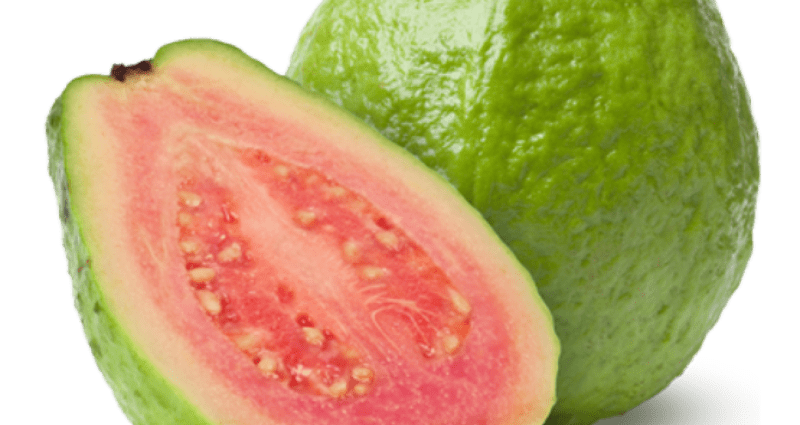Contents
Description
Guava is a genus of plants in the Myrtle family, small evergreen trees and shrubs native to the tropics.
Guava fruits (from 4 to 12 cm) are similar in shape to an apple, covered with a thin skin, and the ripened flesh is red in color, a pronounced pleasant aroma and a sweet or sour taste, reminiscent of pineapple and strawberries.
This tropical fruit contains a lot of vitamins – A, B and especially C, up to 10 times more than citrus fruits (240 mg per 100 grams), so it is recommended to use them for expectant mothers and children to strengthen immunity, quickly restore strength and raise the general body tone. It is simply an ideal fruit for pregnant women, as it contains a balanced composition of vitamins and minerals, especially folic acid.
The guava fruit is native to Mexico, where the fruit has long been grown on huge plantations and used to make desserts and alcoholic beverages. During the colonization of South America, the growing region expanded and now Thailand has become one of the world’s main suppliers of fruit. Here the fruits are called farang – “foreigner”, and tourists know them as guayava.
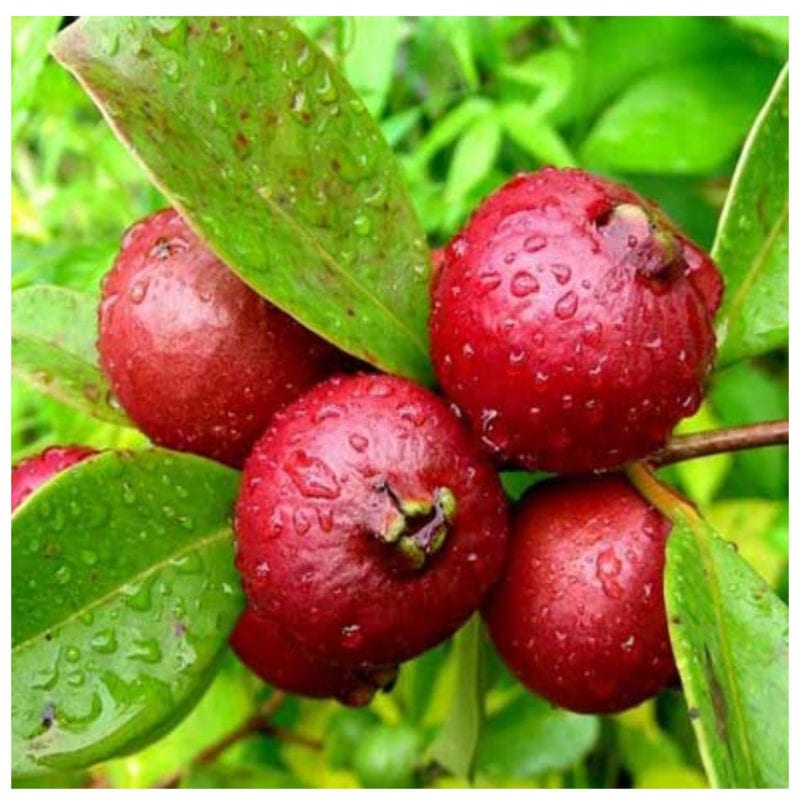
Guava fruits look like small balls with a diameter of 10-15 centimeters. The peel is thin and easily peeled off, depending on the variety it has a color from light green to dark crimson. Inside the juicy pulp there are many small bones – from 100 to 500 pieces.
The taste of guava is very unusual. Ripe, slightly soft fruits are similar in color to watermelon, and taste like raspberries with hints of needles. Strawberry guava is especially popular – the variety has a juicy pulp, reminiscent of a combination of strawberries and pineapple.
Guava fruits are widely used in food (jellies, jams, juices) and in the manufacture of alcoholic beverages.
Growing places
Brazil, Colombia, Mexico, USA, Caribbean, India, Pakistan, Egypt and South Africa.
Composition and calorie content of guava
The benefits of guava lie in the high content of vitamins, micro and macro elements. The fruit is 81% water, excellent thirst quencher and practically sugar-free.
We present lists of nutrients in guava per 100 grams of fresh pulp.
Vitamins
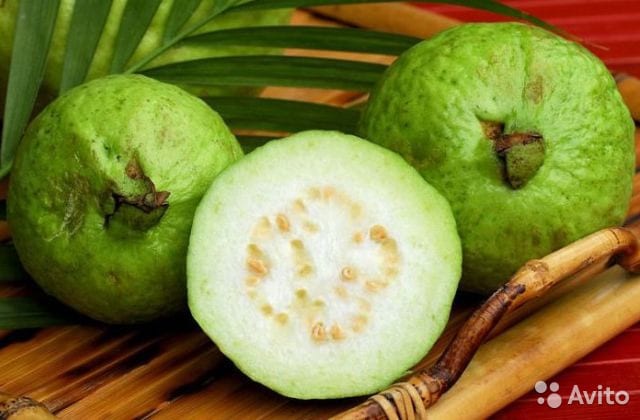
- Vitamin A (beta-carotene) – 0.3 mg
- Vitamin B1 (thiamine) – 0.07 mg
- Vitamin B2 (riboflavin) – 0.07 mg
- Niacin (vitamin B3 or vitamin PP) – 1.2 mg
- Vitamin B5 (pantothenic acid) – 0.2 mg
- Vitamin B6 (pyridoxine) – 0.06 mg
- Folic acid (vitamin B9) – 50 mcg
- Vitamin C (ascorbic acid) – up to 240 mg
- Vitamin E (tocopherol) – 1.1 mg
- Trace elements
- Iron – 1.2 mg
- Manganese – 145 mcg
- Copper – 0.25 mg
- Selenium – 0.7 mcg
- Zinc – 0.25 mg
- Macronutrients
- Potassium – 420 mg
- Calcium – 20 mg
- Magnesium – 12 mg
- Sodium – 5 mg
- Phosphorus – 42 mg
Calorie content of guava is 68 calories per 100 g
Why guava is good for you
Guava fruits are a natural source of vitamins and microelements in a balanced composition. The low glycemic index is suitable for people with diabetes and those on a diet. In Mexico, guava is considered the fruit of longevity – if you eat 3-4 pieces daily, you can get rid of many diseases.
General benefit of Guava
Guava has 10 times more vitamin C than citrus fruits. Regular consumption of fresh fruit and in salads strengthens the immune and lymphatic systems, improves the overall tone of the body.
The fruit has an astringent, bactericidal and antispasmodic effect; you need to eat guava with seeds, which contain substances that restore the intestinal microflora.
The fruit is recommended for the diet of people suffering from disorders of the central nervous system. In particular, guava is included in the diet for the treatment of epilepsy.
For men
The plant has an analgesic effect. For joint stretches, bruises after the gym and other injuries, guava leaves are tied to the sore spot and left for several hours until the pain decreases.
The juicy pulp of the fruit stimulates the brain and contains acids that activate the transmission of signals in the brain. Before an important exam or at work, eat half a fruit to boost your focus.
For women
Guava contains a balanced combination of calcium, phosphorus and iron – essential trace elements in the diet of a pregnant woman. It is recommended to eat 1-2 fruits daily.
The fruit has a positive effect on the production of the female hormone estrogen. During menopause, you need to eat 1 fruit a day daily to normalize the endocrine system.
Guava contains copper, which stimulates the production of red blood cells. During menstruation, a woman loses up to 300 ml of blood, on these days it is necessary to eat 1 fruit per day to replenish hematopoiesis.
For kids
In the cold season, children often get sick due to low immunity. 1/2 of the fruit contains the daily requirement of vitamin C for a child, it is a tasty prevention of colds and an excellent substitute for vitamin pharmacy complexes.

Sweet fruits contain magnesium and potassium, help to cope with stress and overexertion, which often happens to young children who do not know how to cope with their emotions.
Guava harm and contraindications
Guava is sugar free, has a low glycemic index and is recommended for people with diabetes in moderation. But even the most useful fruit has contraindications for use:
- When trying guava for the first time, limit yourself to 1-2 fruits. An allergic reaction to a new product is possible, often with overeating, upset stomach becomes a side effect
- Unripe fruits are harmful for diseases of the kidneys and adrenal glands
- It is strictly forbidden to try to bite through the bones of the guava, so as not to break your teeth
- You should not eat fruit for people with high stomach acidity, sweet and sour fruits can provoke heartburn.
How to choose Guava
Choosing a delicious, ripe, but not overripe guava is not easy. Do you have the opportunity to go shopping with someone who knows a lot about exotic fruits? Be sure to observe how the fruits he chose look like, remember their taste and aroma. If there is no expert nearby, you will have to remember everything you read on this issue and try to apply theoretical knowledge in practice.
What are the signs of a ripe guava?
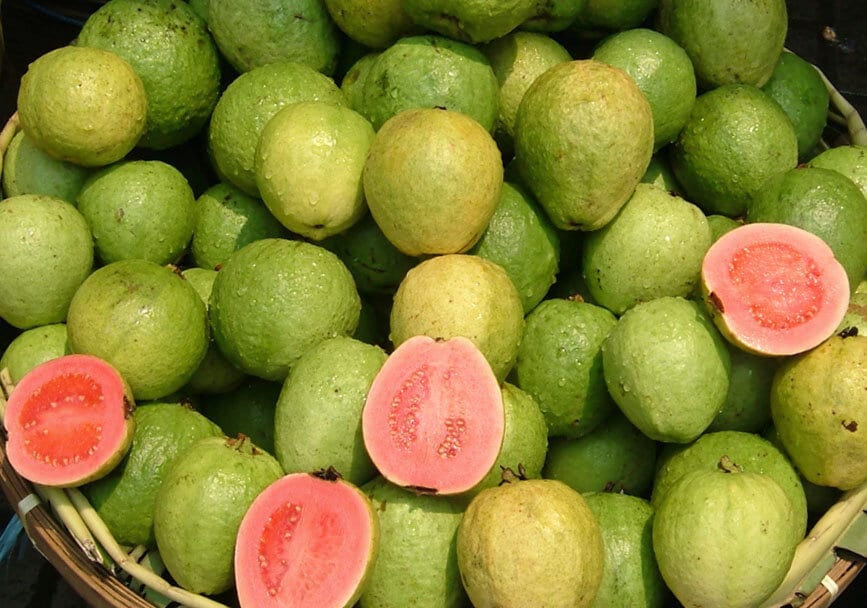
Peel color
Fully ripe guava fruit usually does not have a uniform color. Often (but not always) its shade depends on the color of the pulp. In fruits with yellow or orange flesh, it is yellow, and if the flesh is red or burgundy, the same shade is present on the peel. Only fruits with white or green pulp, even when ripe, do not change the color of the peel, therefore, to determine the degree of their ripeness, you will have to focus on other signs.
Also, when choosing a guava, evaluate the appearance of the fruit. External damage, cracks, dark spots, small dents are unacceptable: the taste will be mediocre, not to mention the fact that the damaged fruits deteriorate and rot very quickly.
Pulp color
In unripe guava fruits, the pulp has a greenish color, as it ripens, it acquires white or, less often, yellow, hot pink, red and even burgundy shades. In fruits with green pulp, the color practically does not change.
Smell
Another characteristic feature of a ripe guava is its aroma – sweet, very intense, discernible within a radius of several meters. If the fruit you have chosen almost does not smell, this means that it has not yet matured. But be careful: if the sourness is clearly felt in the smell of guava, the fruit is overripe and cannot be eaten.
Taste
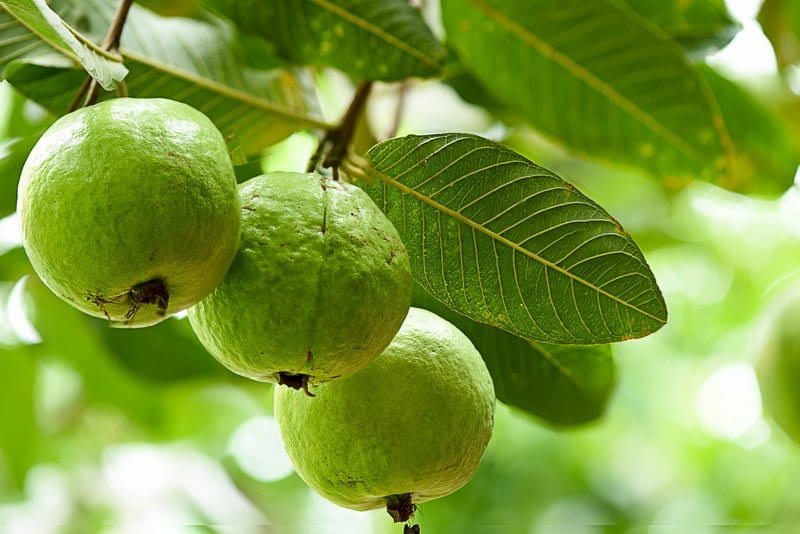
Fully ripe guava has a very sweet taste. Determining which of the familiar fruits it looks like is quite difficult. Many describe it as the taste of pineapple with a hint of lemon or berries – strawberries, raspberries, but sweetness is the main sign of a ripe fruit. Unripe guava is somewhat sour. For this characteristic sourness, it is appreciated by some gourmets.
Guava harm and contraindications
Guava is sugar free, has a low glycemic index and is recommended for people with diabetes in moderation. But even the most useful fruit has contraindications for use:
- When trying guava for the first time, limit yourself to 1-2 fruits. An allergic reaction to a new product is possible, often with overeating, upset stomach becomes a side effect
- Unripe fruits are harmful for diseases of the kidneys and adrenal glands
- It is strictly forbidden to try to bite through the bones of the guava, so as not to break your teeth
- You should not eat fruit for people with high stomach acidity, sweet and sour fruits can provoke heartburn.
How to choose Guava
Choosing a delicious, ripe, but not overripe guava is not easy. Do you have the opportunity to go shopping with someone who knows a lot about exotic fruits? Be sure to observe how the fruits he chose look like, remember their taste and aroma. If there is no expert nearby, you will have to remember everything you read on this issue and try to apply theoretical knowledge in practice.
Taste qualities
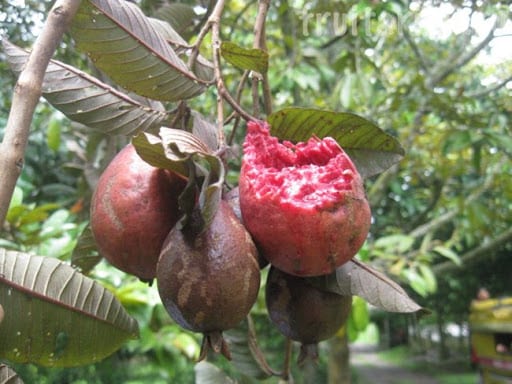
In appearance, the guava resembles a lumpy apple. The taste is varied. There are sour, sweet and sour and sweet varieties. Sweet fruits with a slight sourness are especially appreciated.
Psidium emits a delicate aroma that combines the scent of strawberry, pineapple and quince. Thanks to the wonderful aroma of the fruits, the Spaniards, who first discovered the guava groves, decided that they were in an earthly paradise.
Cooking applications
The tropical apple is eaten raw. Ripe fruits are consumed together with the peel and seeds. In Thailand, guava is eaten unripe: it perfectly cools the body and saves it from overheating. To interrupt the sour and bitter taste, sprinkle the fruits with sugar. In India, salt and black pepper are used as a seasoning for psidium.
You can freeze, dry and preserve guava. It is used for making juices, compotes, syrups, sorbet, tonics, salads, mashed potatoes, “fruit oil”, ketchup, pasta, as well as for flavoring drinks. Due to the high content of pectins, tropical apples are used to make jelly, confiture, marmalade and jam. Add fruits to ice cream, waffles, puddings, yoghurts, milkshakes. Guava cheese is one of the best oriental sweets. They also make a filling for pies from it.

Guava goes well with red meat, tomatoes, bell peppers, dairy products, waffles, puddings, sweet and sour fruits, as well as cilantro, garlic, chili, red onions. It gives an exquisite taste to fruit and vegetable salads. Tropical apple jelly is an excellent side dish for fish, pork and venison dishes.
Medical use of guava
Guava (Thai name – farang, which means “foreigner”) was introduced to Thailand by the Spaniards.
In many countries, the properties of guava are used in medicine, the fruit has antimicrobial, bactericidal, astringent and antiseptic properties, it contains five times more vitamin C than an orange.
It is curious that not only guava fruits are used for medicinal purposes, but also leaves, flowers and bark. Guava leaves are brewed like tea and drunk for indigestion, dysentery, menstrual irregularities and dizziness, and are used externally for skin diseases.










